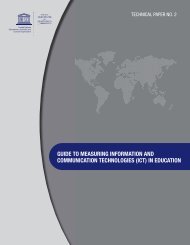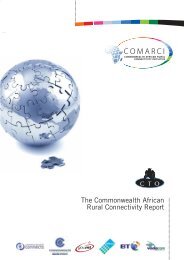ict in agriculture - Commonwealth Telecommunications Organisation
ict in agriculture - Commonwealth Telecommunications Organisation
ict in agriculture - Commonwealth Telecommunications Organisation
You also want an ePaper? Increase the reach of your titles
YUMPU automatically turns print PDFs into web optimized ePapers that Google loves.
SECTION 1 — OVERVIEW OF ICT IN AGRICULTURE: OPPORTUNITIES, ACCESS, AND CROSS-CUTTING THEMES 19<br />
place. For example, the ICT layer carry<strong>in</strong>g the highest value<br />
proposition for end users is the content/service layer. 6 The<br />
framework makes it possible to consider the f<strong>in</strong>ancial viability<br />
of all cont<strong>in</strong>gent layers (network capacity, availability of<br />
appliances, customer support, and so on) and how they may<br />
affect the value derived from the content/service layer.<br />
From a regulatory standpo<strong>in</strong>t, the Ra<strong>in</strong>bow approach captures<br />
the significance of the separation between layers,<br />
most prom<strong>in</strong>ently the separation between the carriage and<br />
the content layers. Focus<strong>in</strong>g regulatory efforts with<strong>in</strong> layers<br />
and enabl<strong>in</strong>g competition with<strong>in</strong> and between layers is<br />
central to achiev<strong>in</strong>g quality end-user services at affordable<br />
prices. From a regulatory policy perspective, the layered<br />
structure illustrates the trend <strong>in</strong> policy to enable competition<br />
among technologies deliver<strong>in</strong>g comparable functionality by<br />
follow<strong>in</strong>g the pr<strong>in</strong>ciples of competition, technology neutrality,<br />
and licens<strong>in</strong>g flexibility.<br />
Ensur<strong>in</strong>g competition with<strong>in</strong> each of the layers is a longstand<strong>in</strong>g<br />
policy priority, especially where the economies of scale<br />
are conducive to monopolistic market structure. 7 Market liberalization<br />
and free entry give <strong>in</strong>cumbents <strong>in</strong>centives to pursue<br />
a higher quality of service. For example, start<strong>in</strong>g <strong>in</strong> 1992<br />
Thailand sought to break up the Communication Authority of<br />
Thailand’s monopoly over <strong>in</strong>ternational gateway services by<br />
<strong>in</strong>troduc<strong>in</strong>g concessions to private companies under buildtransfer-operate<br />
agreements. The entry of the private sector<br />
alongside state-owned enterprises, such as the Telephone<br />
Organization of Thailand, led to remarkable expansion of subscriptions<br />
for both fixed and mobile services. Yet the level<br />
and the degree of competition <strong>in</strong> the fixed l<strong>in</strong>e and mobile<br />
subsectors varied considerably because of the number of<br />
concessions and their terms and conditions (Nikomborirak<br />
and Cheevasittiyanon 2008). Competition <strong>in</strong> the mobile market<br />
yielded improved connectivity and affordability, while the<br />
fixed-l<strong>in</strong>e subsector stagnated.<br />
The lesson is that the welfare benefits of market liberalization<br />
are achieved by implement<strong>in</strong>g complementary policies<br />
on competition that enable market pric<strong>in</strong>g and restr<strong>ict</strong> predatory<br />
pric<strong>in</strong>g by <strong>in</strong>cumbents fac<strong>in</strong>g new entrants throughout<br />
the structural layers of the ICT sector. In Thailand, fixed-l<strong>in</strong>e<br />
concessions were restr<strong>ict</strong>ed by stipulated fixed-call rates<br />
6 Layer number 4 <strong>in</strong> figure 2.1.<br />
7 International Internet gateways and local-loop or “last mile” fixed<br />
networks are examples. Local-loop networks are the fixed networks<br />
that deliver connectivity from the local exchange to the<br />
homes of end-users. Because of the high cost of entry <strong>in</strong> develop<strong>in</strong>g<br />
these networks, this segment is conducive to a monopolistic<br />
market structure.<br />
ECONOMIC AND SECTOR WORK<br />
and upper bounds on the number of subscribers, which<br />
skewed the viability of fixed-l<strong>in</strong>e rollouts by private concession<br />
holders.<br />
In addition to competition, technology neutrality is another<br />
lead<strong>in</strong>g regulatory policy pr<strong>in</strong>ciple for ensur<strong>in</strong>g the affordability<br />
of ICTs. Technology neutrality is the pr<strong>in</strong>ciple of refra<strong>in</strong><strong>in</strong>g<br />
from specify<strong>in</strong>g technology requirements with<strong>in</strong> telecommunications<br />
licenses. Historically, specify<strong>in</strong>g technology<br />
requirements was a means of stimulat<strong>in</strong>g domestic equipment<br />
manufactur<strong>in</strong>g, but technology neutrality is advisable<br />
with<strong>in</strong> the present rapidly evolv<strong>in</strong>g IT <strong>in</strong>dustry, because regulatory<br />
decisions on technology selection can be risky (box 2.1<br />
presents an example from Korea).<br />
BOX 2.1: The Risks of Pick<strong>in</strong>g W<strong>in</strong>ners <strong>in</strong> the Rapidly<br />
Evolv<strong>in</strong>g IT Industry<br />
In Korea, the licens<strong>in</strong>g of new technologies arguably<br />
led to market growth for domestic equipment manufacturers<br />
such as Samsung and LG, yet this strategy may<br />
prove more risky <strong>in</strong> the IT doma<strong>in</strong>. Government support<br />
for WiBro, a Korean version of mobile WiMAX (a telecommunications<br />
protocol that provides fixed and mobile<br />
Internet access), has s<strong>in</strong>ce been viewed as misguided.<br />
By the end of 2008, WiBro had attracted only 170,000<br />
customers for Korea Telecom and SK Telecom comb<strong>in</strong>ed,<br />
a fraction of the government’s expected 1.4 million subscribers.<br />
With<strong>in</strong> the Korean market, LTEa mobile broadband<br />
services were emerg<strong>in</strong>g as a more viable alternative<br />
to WiBro, and both Korea Telecom and SK Telecom<br />
announced plans to launch commercial LTE services at<br />
the expense of languish<strong>in</strong>g WiBro services.<br />
Source: Author, based on Kim 2009a, 2009b.<br />
(a) Long Term Evolution (LTE) is a prelim<strong>in</strong>ary mobile communication<br />
standard, formally submitted as a candidate 4G system to ITU-T <strong>in</strong> late<br />
2009. Commitment to LTE among mobile network operators has been<br />
grow<strong>in</strong>g steadily.<br />
Because no specific technology standards are designated,<br />
technology neutrality widens the scope for competition<br />
with<strong>in</strong> each layer of the Access Ra<strong>in</strong>bow. Compet<strong>in</strong>g operators<br />
choose the technology standards that allow them to<br />
deliver services cost-effectively. The regulatory policy drift<br />
toward technology neutrality is supported by technology<br />
developments that lead to <strong>in</strong>creased standards of <strong>in</strong>teroperability<br />
(see Rossotto et al. 2010).<br />
The ma<strong>in</strong> policy lever for assur<strong>in</strong>g market competition and<br />
technology neutrality is flexible licens<strong>in</strong>g policies and the

















